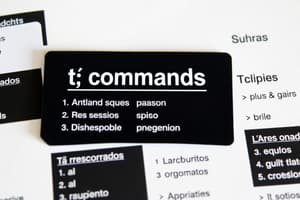Podcast
Questions and Answers
What is the imperative form of 'hablar' for the tú form?
What is the imperative form of 'hablar' for the tú form?
- Hablas
- Habla (correct)
- Hablamos
- Hable
How do you form the positive imperative for the vosotros form?
How do you form the positive imperative for the vosotros form?
- By adding -ar to the infinitive
- By using the 3rd person singular form of the present tense
- By changing the -r at the end of the infinitive to a -d (correct)
- By dropping the -ar at the end of the infinitive
What is the imperative form of 'decir' for the tú form?
What is the imperative form of 'decir' for the tú form?
- Di (correct)
- Diga
- Decir
- Dice
When speaking to an adult or someone you don't know, which command form is used?
When speaking to an adult or someone you don't know, which command form is used?
What is the imperative form of 'levantarse' for the vosotros form?
What is the imperative form of 'levantarse' for the vosotros form?
What is the imperative form of 'hacer' for the vosotros form?
What is the imperative form of 'hacer' for the vosotros form?
When speaking to a group of friends, which command form is used?
When speaking to a group of friends, which command form is used?
To form the imperative of an –ER verb in the usted command, you should
To form the imperative of an –ER verb in the usted command, you should
What is the correct negative imperative form of the verb 'hablar' for 'tú'
What is the correct negative imperative form of the verb 'hablar' for 'tú'
What is the purpose of using the present subjunctive form in formal commands
What is the purpose of using the present subjunctive form in formal commands
What is the negative imperative form of the verb 'beber' for 'ustedes'
What is the negative imperative form of the verb 'beber' for 'ustedes'
What is the correct imperative form of the verb 'escuchar' for 'vosotros'
What is the correct imperative form of the verb 'escuchar' for 'vosotros'
Flashcards are hidden until you start studying
Study Notes
Imperatives in Spanish
Tú Command
- Used to give commands to friends, family members, or pets
- Formed using the 3rd person singular form of the present tense
- Examples:
- Hablar (to speak) → ¡Habla! (Speak!)
- Trabajar (to work) → ¡Trabaja! (Work!)
- Comer (to eat) → ¡Come! (Eat!)
- Irregular verbs in the tú form:
- Decir (to say) → di
- Hacer (to make/do) → haz
- Salir (to go out) → sal
- Ser (to be) → sé
- Tener (to have) → ten
- Ir (to go) → ve
- Poner (to put) → pon
- Venir (to come) → ven
Vosotros Command
- Used to give commands to a group of friends, family members, or pets
- Formed by changing the -r at the end of the infinitive to a -d
- Examples:
- Hablar (to speak) → ¡hablad!
- Correr (to run) → ¡corred!
- With reflexive verbs, drop the -d before adding the reflexive pronoun
- Levantarse → ¡levantaos!
- Acostarse → ¡acostaos!
- Verbs that were previously irregular in the tú command follow the same pattern in the vosotros command
- Salir → ¡salid!
- Poner → ¡poned!
- Tener → ¡tened!
- Venir → ¡venid!
- Decir → ¡decid!
- Ser → ¡sed!
- Ir → ¡id!
- Hacer → ¡haced!
Usted/Ustedes Command
- Used to give commands to an adult or someone you don't know
- Used for formal commands
- Formed using the present subjunctive endings for 3rd and 6th person
- Examples:
- -AR verbs: Hablar (to speak) → ¡hable! / ¡hablen!
- -ER and -IR verbs: Tener (to have) → ¡tenga! / ¡tengan!
Negative Imperatives
- Use the present subjunctive form for all negative commands
- Examples:
- Tú: No estudies (don't study)
- Vosotros: No estudiéis (don't study)
- Usted: No estudie (don't study)
- Ustedes: No estudien (don't study)
Studying That Suits You
Use AI to generate personalized quizzes and flashcards to suit your learning preferences.



